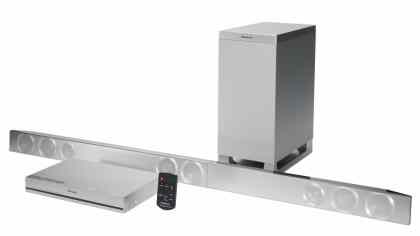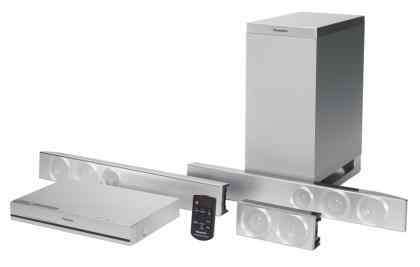Panasonic HTB770 review
Like other soundbars, the SC-HTB770 will fit under any TV, but it can also split into three separate speakers to create a 3.1-channel setup. The SC-HTB770 is broken down into individual parts in the box, and it’s up to you if you want to connect them using the bundled brackets to create the soundbar or use plastic stands instead to position them in a traditional front and centre layout. Screws are provided for both configurations, and it took only a few minutes to get everything connected.

Now it's a soundbar ...
The speakers themselves contain three drivers in each of the front speakers and two in the centre speaker. They look great from the front, thanks to a silver brushed-metal finish that matches Panasonic’s 2013 TV range, but the rear casing is made from less attractive black plastic. Each speaker has a wall mount, so you could hang them separately.

... and now it's a 3.1 speaker system
The matching subwoofer is wireless, and is preconfigured to work with the rest of the system; you only need to turn it on. We used the subwoofer 10 feet away from the rest of the system without problems, so the system should work in the majority of living rooms. It has a 16cm woofer and is fairly compact, so you shouldn’t have a problem placing it in your room.
In its sound bar configuration, the SC-HTB770 is incredibly long, and Panasonic recommends you use it with 55-65in TVs. Panasonic has also included a breakout box that provides all the inputs. Unfortunately, you must connect the three soundbar speakers to the breakout box via wires, which could be a problem if you’re fussy about cable management.
The breakout box has three HDMI inputs and a single HDMI output at the back of the unit, which is a much better collection of ports than you’ll see on many other soundbars. Conveniently, the system supports Audio Return Channel, which means you can use it to play audio from your TV. The breakout box also has a digital optical audio input, but you it doesn’t have a 3.5mm auxiliary input, which is a real shame. On a more positive note, integrated Bluetooth lets you stream music from a smartphone or tablet to the SC-HTB770 wirelessly.

The metallic finish, boxy shape and green activity LEDs of the breakout box look incredibly old fashioned, especially when compared to the likes of Samsung or Sonos, which don’t require an external control box. Even though it uses HDMI, Panasonic has opted not to use an onscreen interface, so you must rely on the LEDs to work out which input is currently active.
The SC-HTB770 produced clear, precise audio when configured as a soundbar, with a dominant centre channel that helped bring dialogue to the front of any scene. You can change this using the remote control should you prefer a more balanced sound. You can also increase the subwoofer volume if you want more bass, although it was easily powerful enough for our small test chamber at the default settings.
We tried each of the five audio presets to see how they affected films and music, and found the Standard and Cinema modes best for Blu-ray discs, as they created a wider sound.
There’s great separation between the left and right channels for panning shots, but because each speaker driver faces forward, sound only travels towards those sat in front of it unlike soundbars that have drivers which face the sides. This made the SC-HTB770’s audio sound much narrower. When configured as separate 3.1 speakers, the SC-HTB770 had far better separation, although this obviously depends on where you place each satellite speaker.
The SC-HTB770 is considerably cheaper than some similar models from the likes of Samsung and Sonos, but it certainly can’t compete in terms of looks or ease of use. We wish Panasonic had fully committed to making a sound bar instead of this hybrid, as it could have streamlined the design, removed the need for a breakout box and eliminated several of the cables. We also think most people only want one speaker system, not two, and are likely to leave the SC-HTB770 in one configuration rather than switch between them. However, if you’re unsure whether or not a soundbar is right for you, the SC-HTB770 will let you try it one. If it isn’t, you can always use it as a traditional 3.1 speaker system.
Details | |
|---|---|
| Price | £430 |
| Rating | *** |
Connections | |
| HDMI inputs | 3 |
| HDMI outputs | 1 |
| Component inputs | 0 |
| Component outputs | 0 |
| Output resolutions | 480i, 480p, PAL (576i), 576p, 720p, 1080i, 1080p |
| Total SCART sockets | 0 |
| SCART socket type | N/A |
| S-Video input | 0 |
| S-video output | 0 |
| Composite inputs | 0 |
| Composite outputs | 0 |
| Stereo phono inputs | 0 |
| Stereo phono outputs | 0 |
| Coaxial S/PDIF inputs | 0 |
| Coaxial S/PDIF outputs | 0 |
| Optical S/PDIF inputs | 2 |
| Optical S/PDIF outputs | 0 |
| Multi-channel input | yes |
| Speaker configuration | 3.1 |
| Main unit end speaker connection type | proprietary |
| Speaker end speaker connection type | spring terminals |
| Other connections | none |
| Wired network ports | none |
| Wireless networking support | Bluetooth |
Playback | |
| Surround sound formats | Dolby Digital, Dolby Pro Logic II, DTS |
| Optical drive | no |
| Region free | N/A |
| Supported playback disc formats | N/A |
| Audio format support | N/A |
| Video playback formats | N/A |
| Image viewing formats | N/A |
| Radio | none |
Speakers | |
| Speaker configuration | 3.1 |
| RMS power output | 300W |
| RMS power centre | 60W |
| RMS power front | 120W |
| RMS power surround | N/A |
| RMS power subwoofer | 120W |
| Wall mountable | yes |
| Centre speaker cable length | 1.5m |
| Front speaker cable length | 3.0m |
| Surround speaker cable length | N/A |
General | |
| Extras | remote control, cables, mounting brackets |
| Size | 310x188x45mm |
| Subwoofer dimensions | 180x306x408mm |
| Centre speaker dimensions | N/A |
| Front speaker dimensions | 1230x41x68mm |
| Surround speaker dimensions | N/A |
| Power consumption standby | 0W |
| Power consumption on | 51W |
Buying Information | |
| Price | £430 |
| Warranty | one year RTB |
| Supplier | http://shop.panasonic.co.uk |
| Details | www.panasonic.co.uk |
